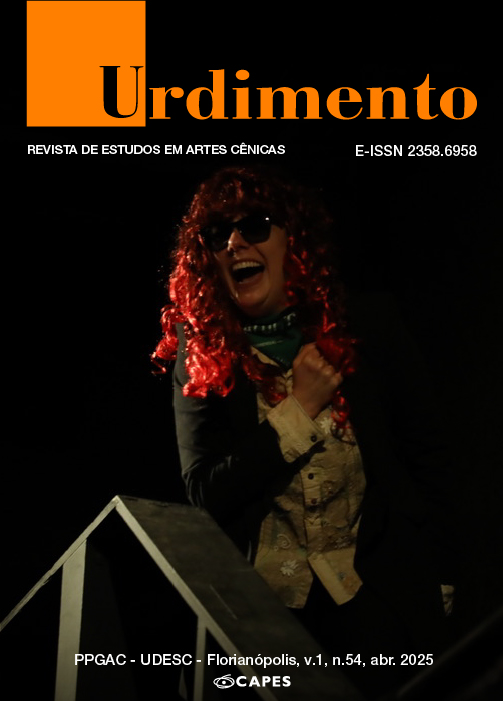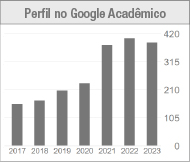La Partituras corporales: una visión general de la escritura coreográfica
DOI:
https://doi.org/10.5965/1414573101542025e119Palabras clave:
notación coreográfica, captura de movimiento, escritura del cuerpo, William ForsytheResumen
Desde las rudimentarias notaciones coreográficas, creadas a partir del siglo XV, hasta los más recientes métodos digitales de captación del movimiento, se observa, por un lado, la alternancia entre presencia y ausencia de la figura humana y, por otro, el desarrollo de una escritura en movimiento que, basada en la noble intención de preservación y transmisión, en ocasiones termina siendo válida en sí misma, como resultado parcial de un proceso de creación. Cuando se acercan problemas de escritura propios de la música y la danza, se percibe en la obra de William Forsythe un doble sentido en el uso de la partitura: el de la obra a la notación y el de la notación a la obra.
Descargas
Citas
ANDERSON, Jack. Idealists, materialists, and the thirty-two fouettés [1975]. In: COPELAND, Roger; COHEN, Marshall (Org.) What is dance? Readings in Theory and Criticism. Oxford/ Nova York/ Toronto/ Melbourne: Oxford University Press, 1983, p. 410-419.
BAZIN, André. Por um cinema impuro - defesa da adaptação [1952]. In: O que é o cinema? São Paulo: Cosac Naify, 2014, p. 113-135.
CULLIN, Olivier. Laborintus: essais sur la musique au Moyen Âge. Paris: Fayard, 2004.
DUICU, Dragos. Phénoménologie du mouvement: Patočka et l’héritage de la physique aristotélicienne. Paris: Hermann, 2014.
EISENSTEIN, Serguei. O sentido do filme. Rio de Janeiro: Jorge Zahar, 1990.
FORSYTHE, William (et alii). Synchronous objects. Columbus, Ohio: mar 2009. https://synchronousobjects.asc.ohio-state.edu/SODanceDataObjectsEssays.pdf. Acesso em: 16 set. 2024.
GASPARINI, Isis. William Forsythe: encontros entre dança, cinema e artes visuais. Fórum Permanente, 2017. https://www.forumpermanente.org/rede/vertices-vetores-e-dialogos/william-forsythe. Acesso em: 16 set. 2024.
GUEST, Ann Hutchinson. Dance notation: the process of recording movement on paper. Londres: Dance Books, 1984.
GUEST, Ann Hutchinson. Labanotation: the system of analyzing and recording movement. Nova York: Routledge, 2005.
GOODMAN, Nelson. The role of notations [1968]. In: COPELAND, Roger; COHEN, Marshall (Org.) What is dance? Readings in Theory and Criticism. Oxford/ Nova York/ Toronto/ Melbourne: Oxford University Press, 1983, p. 399-410.
HALL, Fernau. Dance notation and choreology [1964]. In: COPELAND, Roger; COHEN, Marshall (Org.) What is dance? Readings in Theory and Criticism. Oxford/ Nova York/ Toronto/ Melbourne: Oxford University Press, 1983, p. 390-399.
LOUPPE, Laurence (Org.) Traces of dance: drawings and notations of choreographers. Paris: Dis Voir, 1994.
MORAES, Juliana. O conceito de coreografia em transformação. Urdimento – Revista de Estudos em Artes Cênicas. Florianópolis, v.1, n.34, p. 362-377, mar./abr. 2019. DOI: 10.5965/1414573101342019362.
PASOLINI, Pier Paolo. L’expérience hérétique. Paris: Payot, 1976.
PHELAN, Peggy. Unmarked: The Politics of Performance. Nova York: Routledge, 1996.
SPANGHERO, Maíra. Dançando números, formas e padrões. Revista Científica/FAP, Curitiba, v. 11, n. 1, p.123-144, 2014. Acesso em: 12 set. 2024. DOI: 10.33871/19805071.2014.11.1.1377.
VINCS, Kim. Virtualizing Dance. In: ROSENBERG, Douglas (Org.) The Oxford Handbook of Screendance Studies. Oxford/ Nova York: Oxford University Press, 2016, p. 263-282.
XAVIER, Ismail. O discurso cinematográfico: a opacidade e a transparência. 3a ed. São Paulo: Paz e Terra, 2005.
Publicado
Cómo citar
Número
Sección
Licencia
Derechos de autor 2025 Urdimento

Esta obra está bajo una licencia internacional Creative Commons Atribución 4.0.
Declaración de Derecho de lo Auctor
Los artículos publicados por la revista son de uso gratuito. Los derechos de autor son todos cedidos a la revista. Los artículos cuyos autores son identificados representan la expresión del punto de vista de sus autores y no la posición oficial de la revista Urdimento. El autor o los autores se comprometen a que publiquen material referente al artículo publicado en la Revista Urdimento mencionar dicha publicación de la siguiente forma:
"Este artículo fue publicado originalmente por la revista Urdimento en su volumen (poner el volumen), número (poner el número) en el año de (poner el año) y puede ser accedido en: http://www.revistas.udesc.br/index.php/urdimento
Este periódico utiliza una Licencia de Atribución Creative Commons - CC - BY 4.0.



